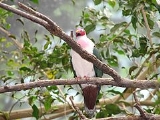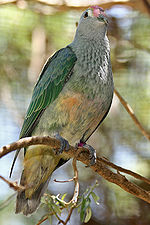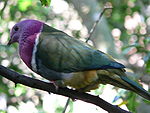
Fruit-dove
Encyclopedia
The fruit doves are a genus
(Ptilinopus) in the pigeon and dove family
(Columbidae). These colourful, frugivorous
doves are found in forests and woodlands in Southeast Asia
and Oceania
. It is a large genus with about 50 species, some threatened
or already extinct.
. Males and females of many fruit dove species look very different. For example, the female Many-coloured Fruit Dove shares the male’s crimson crown and deep pink undertail feathers, but is otherwise green, whereas the male has a crimson on the upper back and has areas of yellow, olive, cinnamon, and grey.
, in the Philippines
, and in the biogeographical region of Wallacea
. Some species have ranges as far west as the Sunda Islands
, others north to Taiwan
, south to Australia
, and east into Polynesia
.
Fruit doves, as their name implies, eat fruit -- ficus
is especially important -- and live in various kinds of forest or woodland. Some species are restricted to primary forest, such as lowland rainforest
, montane forest, or monsoon forest, while others prefer secondary forest
or disturbed areas. Some species specialize in particular habitats, from lowland coastal forest to the cloud forest
or moss forest of high altitudes. Some species of fruit doves are only found in habitats dominated by particular plants, such as mangrove
, eucalyptus
, or pandanus
. Only a few species can commonly be seen around human habitation, these include the Knob-billed Fruit Dove, Makatea Fruit Dove, and Black-naped Fruit Dove, which are known to visit gardens and such.
Much is still to be learned about fruit doves. Many species are shy and difficult to observe in their natural habitat. For example, there are several species in the Philippines, and for most of them, little or nothing is known of their breeding or nesting behavior.
, including the Carunculated Fruit Dove, Knob-billed Fruit Dove, and others; these are notable for their grey colouration on the head or shoulder and/or enlarged cere (part of the bill). This group is uncharacteristically not sexually dimorphic
, meaning males and females look alike. The Orange Dove, Golden Dove
, and Whistling Dove
, all endemic to Fiji
and sometimes placed in their own genus Chrysoenas, have in common their small size, compact shape, yellow or orange colouration in the males, and hair-like body feathers. They also are known for their rather un-pigeon-like vocalizations, which sound like snapping, barking, or whistling, respectively. Finally, the Pacific Islands provide homes to a number of species that share generally green colouration with crimson caps or crowns, ventriloquial cooing or hooting, and a distinct texture of the breast feathers. The Grey-green Fruit Dove is typical of this group. Recent evidence suggests Ptilinopus as presently defined is paraphyletic as Alectroenas and Drepanoptila are embedded within it.


Genus
In biology, a genus is a low-level taxonomic rank used in the biological classification of living and fossil organisms, which is an example of definition by genus and differentia...
(Ptilinopus) in the pigeon and dove family
Family (biology)
In biological classification, family is* a taxonomic rank. Other well-known ranks are life, domain, kingdom, phylum, class, order, genus, and species, with family fitting between order and genus. As for the other well-known ranks, there is the option of an immediately lower rank, indicated by the...
(Columbidae). These colourful, frugivorous
Frugivore
A frugivore is a fruit eater. It can be any type of herbivore or omnivore where fruit is a preferred food type. Because approximately 20% of all mammalian herbivores also eat fruit, frugivory is considered to be common among mammals. Since frugivores eat a lot of fruit they are highly dependent...
doves are found in forests and woodlands in Southeast Asia
Southeast Asia
Southeast Asia, South-East Asia, South East Asia or Southeastern Asia is a subregion of Asia, consisting of the countries that are geographically south of China, east of India, west of New Guinea and north of Australia. The region lies on the intersection of geological plates, with heavy seismic...
and Oceania
Oceania
Oceania is a region centered on the islands of the tropical Pacific Ocean. Conceptions of what constitutes Oceania range from the coral atolls and volcanic islands of the South Pacific to the entire insular region between Asia and the Americas, including Australasia and the Malay Archipelago...
. It is a large genus with about 50 species, some threatened
Threatened species
Threatened species are any speciesg animals, plants, fungi, etc.) which are vulnerable to endangerment in the near future.The World Conservation Union is the foremost authority on threatened species, and treats threatened species not as a single category, but as a group of three categories,...
or already extinct.
Description
These small- to medium-sized doves generally have short, fan-shaped tails, and are remarkable for their colourful and often glossy plumage, as evidenced in the aptly named Orange Fruit Dove, Flame-breasted Fruit Dove, and Pink-headed Fruit DovePink-headed Fruit Dove
The Pink-headed Fruit Dove, also known as Pink-necked Fruit Dove or Temminck's Fruit Pigeon, is a small colourful dove....
. Males and females of many fruit dove species look very different. For example, the female Many-coloured Fruit Dove shares the male’s crimson crown and deep pink undertail feathers, but is otherwise green, whereas the male has a crimson on the upper back and has areas of yellow, olive, cinnamon, and grey.
Distribution, behaviour, and habitat
This is a large genus, most diverse in and around the island of New GuineaNew Guinea
New Guinea is the world's second largest island, after Greenland, covering a land area of 786,000 km2. Located in the southwest Pacific Ocean, it lies geographically to the east of the Malay Archipelago, with which it is sometimes included as part of a greater Indo-Australian Archipelago...
, in the Philippines
Philippines
The Philippines , officially known as the Republic of the Philippines , is a country in Southeast Asia in the western Pacific Ocean. To its north across the Luzon Strait lies Taiwan. West across the South China Sea sits Vietnam...
, and in the biogeographical region of Wallacea
Wallacea
Wallacea is a biogeographical designation for a group of Indonesian islands separated by deep water straits from the Asian and Australian continental shelves. Wallacea includes Sulawesi, the largest island in the group, as well as Lombok, Sumbawa, Flores, Sumba, Timor, Halmahera, Buru, Seram, and...
. Some species have ranges as far west as the Sunda Islands
Sunda Islands
The Sunda Islands are a group of islands that form part of the Malay archipelago.They are further divided into the Greater Sunda Islands and the Lesser Sunda Islands.-Administration:...
, others north to Taiwan
Taiwan
Taiwan , also known, especially in the past, as Formosa , is the largest island of the same-named island group of East Asia in the western Pacific Ocean and located off the southeastern coast of mainland China. The island forms over 99% of the current territory of the Republic of China following...
, south to Australia
Australia
Australia , officially the Commonwealth of Australia, is a country in the Southern Hemisphere comprising the mainland of the Australian continent, the island of Tasmania, and numerous smaller islands in the Indian and Pacific Oceans. It is the world's sixth-largest country by total area...
, and east into Polynesia
Polynesia
Polynesia is a subregion of Oceania, made up of over 1,000 islands scattered over the central and southern Pacific Ocean. The indigenous people who inhabit the islands of Polynesia are termed Polynesians and they share many similar traits including language, culture and beliefs...
.
Fruit doves, as their name implies, eat fruit -- ficus
Ficus
Ficus is a genus of about 850 species of woody trees, shrubs, vines, epiphytes, and hemiepiphyte in the family Moraceae. Collectively known as fig trees or figs, they are native throughout the tropics with a few species extending into the semi-warm temperate zone. The Common Fig Ficus is a genus of...
is especially important -- and live in various kinds of forest or woodland. Some species are restricted to primary forest, such as lowland rainforest
Rainforest
Rainforests are forests characterized by high rainfall, with definitions based on a minimum normal annual rainfall of 1750-2000 mm...
, montane forest, or monsoon forest, while others prefer secondary forest
Secondary forest
A secondary forest is a forest or woodland area which has re-grown after a major disturbance such as fire, insect infestation, timber harvest or windthrow, until a long enough period has passed so that the effects of the disturbance are no longer evident...
or disturbed areas. Some species specialize in particular habitats, from lowland coastal forest to the cloud forest
Cloud forest
A cloud forest, also called a fog forest, is a generally tropical or subtropical evergreen montane moist forest characterized by a persistent, frequent or seasonal low-level cloud cover, usually at the canopy level. Cloud forests often exhibit an abundance of mosses covering the ground and...
or moss forest of high altitudes. Some species of fruit doves are only found in habitats dominated by particular plants, such as mangrove
Mangrove
Mangroves are various kinds of trees up to medium height and shrubs that grow in saline coastal sediment habitats in the tropics and subtropics – mainly between latitudes N and S...
, eucalyptus
Eucalyptus
Eucalyptus is a diverse genus of flowering trees in the myrtle family, Myrtaceae. Members of the genus dominate the tree flora of Australia...
, or pandanus
Pandanus
Pandanus is a genus of monocots with about 600 known species. They are numerous palmlike dioecious trees and shrubs native of the Old World tropics and subtropics. They are classified in the order Pandanales, family Pandanaceae.-Overview:...
. Only a few species can commonly be seen around human habitation, these include the Knob-billed Fruit Dove, Makatea Fruit Dove, and Black-naped Fruit Dove, which are known to visit gardens and such.
Much is still to be learned about fruit doves. Many species are shy and difficult to observe in their natural habitat. For example, there are several species in the Philippines, and for most of them, little or nothing is known of their breeding or nesting behavior.
Taxonomy
The many species of this genus can be further grouped by geography and by certain shared characteristics. The fruit doves of the Sunda Islands and northern Australia, such as the Pink-headed Fruit Dove and Banded Fruit Dove, have comparatively longer tails than other species, and are notable for their solid colouration on the head, neck and breast, with a black band across the belly. Another grouping can be made of certain fruit doves endemic to New Guinea, the Moluccas, and the Bismarck ArchipelagoBismarck Archipelago
The Bismarck Archipelago is a group of islands off the northeastern coast of New Guinea in the western Pacific Ocean and is part of the Islands Region of Papua New Guinea.-History:...
, including the Carunculated Fruit Dove, Knob-billed Fruit Dove, and others; these are notable for their grey colouration on the head or shoulder and/or enlarged cere (part of the bill). This group is uncharacteristically not sexually dimorphic
Sexual dimorphism
Sexual dimorphism is a phenotypic difference between males and females of the same species. Examples of such differences include differences in morphology, ornamentation, and behavior.-Examples:-Ornamentation / coloration:...
, meaning males and females look alike. The Orange Dove, Golden Dove
Golden Dove
The Golden Fruit Dove , also known as the Lemon Dove or Yellow Dove, is a small, approximately 20 cm long, short-tailed fruit-dove in the family Columbidae. The common name refers to the males' bright golden-yellow colour. The body feathers appear almost iridescent due to their elongated...
, and Whistling Dove
Whistling Dove
The Whistling Fruit Dove , also known as the Velvet Dove or Yellow-headed Dove, is a small fruit dove from Fiji...
, all endemic to Fiji
Fiji
Fiji , officially the Republic of Fiji , is an island nation in Melanesia in the South Pacific Ocean about northeast of New Zealand's North Island...
and sometimes placed in their own genus Chrysoenas, have in common their small size, compact shape, yellow or orange colouration in the males, and hair-like body feathers. They also are known for their rather un-pigeon-like vocalizations, which sound like snapping, barking, or whistling, respectively. Finally, the Pacific Islands provide homes to a number of species that share generally green colouration with crimson caps or crowns, ventriloquial cooing or hooting, and a distinct texture of the breast feathers. The Grey-green Fruit Dove is typical of this group. Recent evidence suggests Ptilinopus as presently defined is paraphyletic as Alectroenas and Drepanoptila are embedded within it.
Species
- Banded Fruit Dove, Ptilinopus cinctus
- Red-naped Fruit Dove, Ptilinopus dohertyi
- Pink-headed Fruit DovePink-headed Fruit DoveThe Pink-headed Fruit Dove, also known as Pink-necked Fruit Dove or Temminck's Fruit Pigeon, is a small colourful dove....
, Ptilinopus porphyreus - Flame-breasted Fruit Dove, Ptilinopus marchei
- Cream-breasted Fruit Dove, Ptilinopus merrilli
- Yellow-breasted Fruit Dove, Ptilinopus occipitalis
- Red-eared Fruit Dove, Ptilinopus fischeri
- Jambu Fruit DoveJambu Fruit DoveThe Jambu Fruit Dove, is a smallish colourful fruit-dove. It is a resident breeding species in southern Thailand, Malaysia, Brunei and the Indonesian islands of Kalimantan, Sumatra and Java....
, Ptilinopus jambu - Maroon-chinned Fruit Dove, Ptilinopus subgularis
- Black-chinned Fruit Dove, Ptilinopus leclancheri
- Scarlet-breasted Fruit Dove, Ptilinopus bernsteinii
- Wompoo Fruit Dove, Ptilinopus magnificus
- Pink-spotted Fruit Dove, Ptilinopus perlatus
- Ornate Fruit Dove, Ptilinopus ornatus
- Tanna Fruit Dove, Ptilinopus tannensis
- Orange-fronted Fruit Dove, Ptilinopus aurantiifrons
- Wallace's Fruit Dove, Ptilinopus wallacii
- Superb Fruit Dove, Ptilinopus superbus
- Many-coloured Fruit Dove, Ptilinopus perousii
- Crimson-crowned Fruit Dove, Ptilinopus porphyraceus
- Ebon Purple-capped Fruit Dove, Ptilinopus porphyraceus marshallianus - doubtfully distinct; extinct (late 19th century)?
- Palau Fruit Dove, Ptilinopus pelewensis
- Lilac-crowned Fruit Dove, Ptilinopus rarotongensis
- Mauke Fruit Dove, Ptilinopus rarotongensis "byronensis" - extinct (mid-/late 19th century)
- Tubuai Fruit Dove, Ptilinopus sp. - prehistoricLate Quaternary prehistoric birdsPrehistoric birds are various taxa of birds that became extinct before recorded history, or more precisely, before they could be studied alive by bird scientists...
- Mariana Fruit DoveMariana Fruit DoveThe Mariana Fruit Dove, Ptilinopus roseicapilla, also known locally as Mwee’mwe in the Carolinian language, Totot on Guam or Paluman Totut in Northern Mariana Islands, is a small, up to 24 cm long, green fruit dove native and endemic to Guam and the Northern Marianas Islands in the Pacific...
, Ptilinopus roseicapilla

- Rose-crowned Fruit Dove, Ptilinopus regina
- Silver-capped Fruit Dove, Ptilinopus richardsii
- Grey-green Fruit Dove, Ptilinopus purpuratus
- Makatea Fruit Dove, Ptilinopus chalcurus
- Atoll Fruit Dove, Ptilinopus coralensis
- Red-bellied Fruit Dove, Ptilinopus greyii
- Rapa Fruit Dove, Ptilinopus huttoni
- White-capped Fruit Dove, Ptilinopus dupetithouarsii
- Moustached Fruit Dove, Ptilinopus mercierii - extinct (mid-20th century)
- Scarlet-capped Fruit Dove, Ptilinopus insularis
- Coroneted Fruit Dove, Ptilinopus coronulatus
- Beautiful Fruit Dove, Ptilinopus pulchellus
- Blue-capped Fruit Dove, Ptilinopus monacha
- White-bibbed Fruit Dove, Ptilinopus rivoli
- Yellow-bibbed Fruit Dove, Ptilinopus solomonensis
- Claret-breasted Fruit Dove, Ptilinopus viridis
- White-headed Fruit Dove, Ptilinopus eugeniae

- Orange-bellied Fruit Dove, Ptilinopus iozonus
- Knob-billed Fruit Dove, Ptilinopus insolitus
- Grey-headed Fruit Dove, Ptilinopus hyogaster
- Carunculated Fruit Dove, Ptilinopus granulifrons
- Black-naped Fruit Dove, Ptilinopus melanospilus
- Dwarf Fruit Dove, Ptilinopus nainus
- Negros Fruit Dove, Ptilinopus arcanus - possibly extinct (late 20th century?)
- Orange Fruit Dove, Ptilinopus victor
- Golden Fruit Dove, Ptilinopus luteovirens
- Whistling Fruit Dove, Ptilinopus layardi

